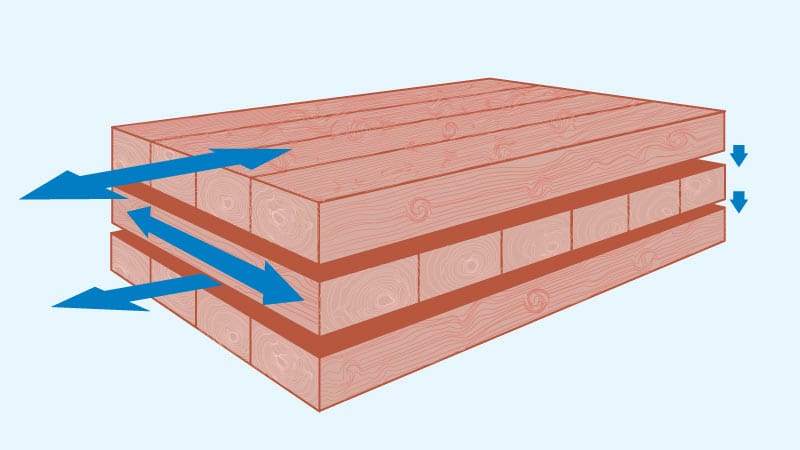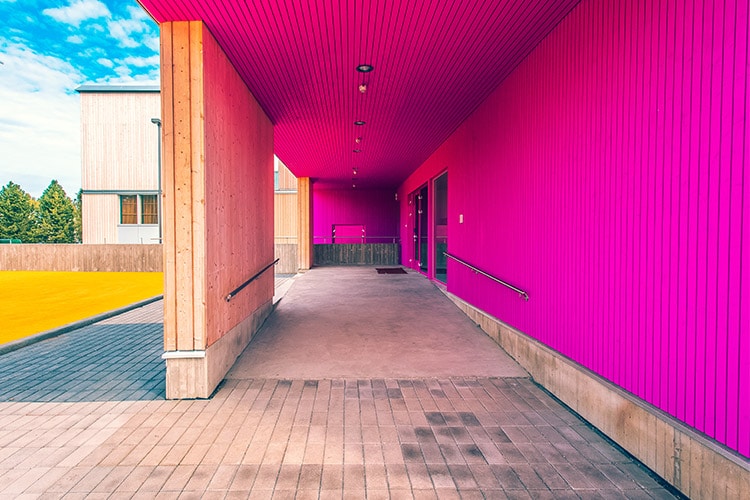While advances in technology have taken the fields of architecture and construction to new heights, one of the latest innovations has a surprising source—the past.
Wood has always been intricately tied to the art of building, but it really fell out of fashion as a material in the late 19th century. Architects discovered that, by using steel and concrete instead, they could build even taller versions of the high-rise structures that were so in-demand and desirable during the era. As well, major urban fires, which had occurred in places such as Chicago and San Francisco, led to the passing of stricter construction codes—some which limited the height of residential wood buildings to as low as five floors.
Development and manufacturing
Cross-laminated timber (CLT) seems destined to bring wood back to the forefront of every designer’s mind. CLT is a highly-engineered and sustainable wood panel product—or, as it has been described by engineers, a kind of “plywood on steroids.”
Even though the material itself may be fundamentally natural, the development of CLT was only possible due to the breakthroughs in technology. CLT was first developed and used in Austria in the 1990s, the result of a government funded, joint industrial-academic research project to engineer a stronger form of wood. Since then, its rising popularity throughout the world seems to speak to the incredible advantages the material provides—for both the companies which construct buildings and those who occupy them.
The way in which CLT is created, and the unique properties which it contains, have the possibility to dramatically change how work is done on-site. CLT, which is manufactured mainly from spruce, is made by attaching parallel wood beams together perpendicularly with adhesive.

Unlike the time-consuming and laborious ways of the past, an architect can now use a computer to design and create material specs. They can then send these 3D files to robots, which will cut the boards to their custom specification.
As a result, floors or walls made from CLT can be fully manufactured before going to the jobsite, allowing workers to simply screw them together upon arrival—an innovation which could, potentially, decrease lead times and lower overall construction costs. Additionally, the light weight of CLT requires less complicated machinery to be brought in on-site—allowing access to difficult locations whose ground, normally, could not support heavier projects.
CLT’s eco-friendly appeal
CLT’s appeal though, extends beyond just the design and development process—the ways in which the material is eco-friendly are a huge draw for the new generation of environmentally minded businesses searching for a location. Due to the fact that it creates no carbon dioxide and, in fact, absorbs the chemical compound, CLT is referred to as a “carbon sink.” As opposed to steel or concrete, whose production generates high levels of emission, CLT continues to store the carbon dioxide it absorbed as a tree even after becoming building material.
The material may not just have a light environmental impact, but be light on the wallet as well—the thermal insulation it achieves, due to the layers of wood, reduce the use (and carbon footprint) of a building’s heating and cooling systems. As if that wasn’t enough, CLT also reduces waste by using odd-shaped timber that otherwise would be rejected by lumber mills.
CLT buildings around the world

Although some cite CLT’s limited track record as a disadvantage when considering its use, the plethora of research already conducted on the material seems to stand as a counter argument to that fact. It has already been employed in various projects, such as the T3 office building in Minneapolis and the University of British Columbia’s Brock Commons Residence Hall. But its use has not been limited to just high-rise buildings—both transportation structures, like the award-winning Mistassini Bridge in Quebec, and pavilions, like Alison Brooks’ “Smile” at the Chelsea College of Arts in London, have been built from CLT.
For those who work in the fields of design and construction, the true potential of CLT could lie in the ways in which such a tech-friendly material speaks to rising entrepreneurs. One of the companies that best seems to encapsulate this idea is Endeavor Real Estate Group, which is using CLT in their creation of their new building, named 901 East Sixth, in Austin, TX.
In a press release about the project, the group described how, “Every generation wants to connect with the spaces they interact with, and Millennials are no different; to live and work in authentic spaces that feel undeniably their own, with a mix of old and new character. The use of cross laminated timber offers a sense of warmth and authenticity of an older building mixed with state-of-the-art design and new technologies.”
However, regardless of generational association, it is hard not to see, not only the possibilities in the future for CLT, but see the material as the future itself.











